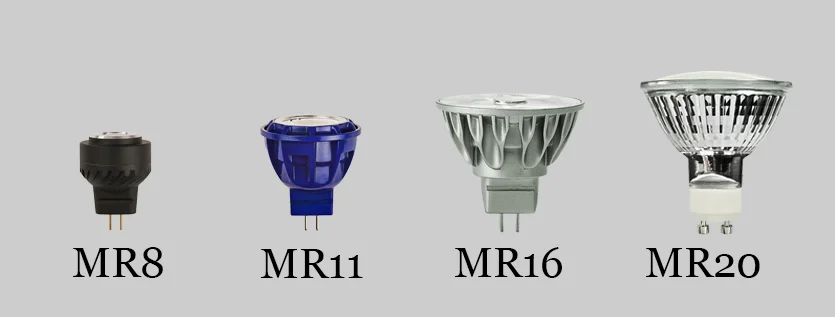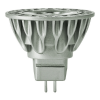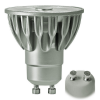Light Bulb Shape Guide: MR-Shape
The MR bulb is a light bulb which focuses its light output into a single focal point. You can find this particular bulb installed in track lights, recessed lights, or even landscape lighting. Even though the creative possibilities are endless, the MR bulb’s many different shapes and forms which can lead to some mild head-scratching. Originally introduced as halogen bulbs, they have most recently been manufactured as energy efficient LED alternatives. Previously, we covered the common household A-Shaped light bulb for the first installment of our Light Bulb Shape guide but for our second installment, we will be covering the MR light bulb.
MR Light Bulb Shapes
Are you unsure of which MR bulb you have? In order to determine the size and shape, you need to identify the variables of the bulb’s shape code. The code designation is made up of two key variables, the first being the prefix “MR” which is an abbreviation for the term, “Multifaceted Reflector.” The second variable is a numeric value that represents the widest part of the bulb measured in eighths of an inch. Although this chart doesn’t cover all the bulb sizes, it reflects the most common types of MR shapes. If you’re unsure of the size, you can always use your handy dandy ruler to measure.
For additional sizes outside of this chart, multiply the number of inches times 8 and add any remaining eights of an inch. If your MR bulb measures 1-5/8 inches across, it’s an MR13 (8+5).
| Shape | Diameter in Inches |
|---|---|
| MR8 | 8/8 |
| MR11 | 1-3/8 |
| MR16 | 2 |
| MR20 | 2-1/2 |
Once you find the correct size, be sure to have the correct voltage rating before acquiring a replacement for your fixtures. MR bulbs are offered but not limited to, 12-volt and 120-volt versions. Be sure to verify the voltage rating of your light bulbs in order to avoid the bulb shorting out.
This image is not to scale. But note the differences in the neck of the bulb, they grow longer as the bulb diameter increases.
MR Light Bulb Base Types
G5.3 Base
GU10 Base
You can find two distinct types of bi-pin bases for MR bulbs which include a plug-in and a twist-and-lock version. The concept for calculating the shape of the base is similar but in some instances includes an addition variable to the code. The prefix “G” is identified as a bi-pin base. Sometimes a second variable may be included in the shape code, represented by the letters U, X, Y, or Z, indicating a different base and/or pin dimensions. For example a G5.3 and a GX5.3 have a different standard minimum and maximum range that the length of the pin must fall between. Depending on manufacturer this number may vary, but as long as the pin is in the specified range, it is identified accordingly. Finally, the third variable is a numerical value which represents the distance (millimeters) from pin to pin. Although the following chart doesn’t cover all the bases pertaining to the MR shape, a few common shapes are shown below.
| Code | Type | Pin to Pin (mm) | Min./Max Pin Length (mm) |
|---|---|---|---|
| GU4 | Plug-in | 4 | 0.95-1.05 |
| G5.3 | Plug-in | 5.33 | 1.47-1.65 |
| GU5.3 | Plug-in | 5.33 | 1.45-1.6 |
| GX5.3 | Plug-in | 5.33 | 1.45-1.6 (Round Pins) |
| GY5.3 | Plug-in | 5.33 | (Flat Pins) |
| GU7 | Twist-and-lock | 7 | N/A |
| GU10 | Twist-and-lock | 10 | N/A |
| GX10 | Twist-and-lock | 10 | N/A |
The typical (GU5.3, GU7, and GU10) base types can be found in your everyday household light bulbs. Keep in mind the light bulb’s code and fixture code should match in order to operate properly. If the sockets aren’t the same code, more than likely the bulb will not fit or will malfunction.
Where are MR Light Bulbs Used?
Due to its small stature, an MR light bulb is ideal for compact spaces to create directional lighting. The dispersion of light from the bulb is measured in degrees and is referred to as a beam angle. Examples of the different types of beam angles are shown below.
| Name | Abbreviation | Degrees | Usage |
|---|---|---|---|
| Very Narrow Spot | VNS | <7 | Task and Accent Lighting |
| Narrow Spot | NS | 8-15 | |
| Spot | S | 16-22 | |
| Narrow Flood | NF | 23-32 | Ambient, Street, and Security Lighting |
| Flood | FL | 33-45 | |
| Wide Flood | WF | 46-59 | |
| Very Wide Flood | VW | >60 |
When an emphasis for a certain space or object is needed, beam angles can be utilized to highlight specific areas such as retail displays, museums, art galleries, or even to create a miniature version of the bat-signal. Whether you’re summoning Gotham City’s favorite hero or competing with your neighbor for landscaping design street cred, the possibilities for an MR bulb are endless.
Have you used an MR bulb for another application we didn’t mention? Share your projects and setups by commenting below! For more lighting facts and know-hows, check our blog for weekly updates or keep in touch with us through our Facebook, Twitter, LinkedIn, or Pinterest.










